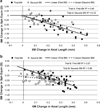Myopia progression in Chinese children is slower in summer than in winter
- PMID: 22797511
- PMCID: PMC4696401
- DOI: 10.1097/OPX.0b013e3182640996
Myopia progression in Chinese children is slower in summer than in winter
Abstract
Purpose: To characterize seasonal variation in the myopic progression of Chinese children.
Methods: Myopia progression data are presented for a total of 85 Chinese children, aged 6 to 12 years, with baseline myopia of -0.75 D to -3.50 D sphere and astigmatism ≤-1.50 D, who wore traditional single-vision spectacles in two clinical trials (trial A: n = 37, trial B: n = 48). Refractive error and axial length data were obtained at 6-month intervals using cycloplegic autorefraction and partial coherence interferometry, respectively. Progression rates for right eyes were defined for the first and second 6 months of the studies and classified in terms of "summer," "autumn," "winter," or "spring" based on the mid-point of the 6-month period between visits.
Results: The mean 6-month spherical equivalent progression was -0.31 ± 0.25 D for summer, -0.40 ± 0.27 D for autumn, -0.53 ± 0.29 D for winter, and -0.42 ± 0.20 D for spring (p < 0.001). Mean axial elongation was 0.17 ± 0.10 mm for summer, 0.24 ± 0.09 mm for autumn, 0.24 ± 0.09 mm for winter, and 0.15 ± 0.08 mm for spring (p < 0.001). Post hoc analysis indicated that data for summer and winter were different from each other at p < 0.05 for both myopia progression and axial elongation after adjusting for age.
Conclusions: Myopia progression in summer months was approximately 60% of that seen in winter, and axial elongation was likewise significantly less in summer. It is unclear whether more time spent outdoors in summer vs. winter is a contributing factor, or the difference in progression rates is a result of "seasonal" variations in the intensity or amount of close work performed. These results indicate that studies of potential myopia treatment strategies should be at least 12 months in duration to take seasonal variations into account.
Figures
References
-
- Grosvenor TP, Goss DA. Clinical Management of Myopia. Boston: Butterworth-Heineman; 1999.
-
- Pärssinen O, Lyyra AL. Myopia and myopic progression among schoolchildren: a three-year follow- up study. Invest Ophthalmol Vis Sci. 1993;34:2794–2802. - PubMed
-
- Luckeish M, Moss FK. Ocular changes in school children during the fifth and sixth grades. Am J Optom. 1939;16:443–450.
Publication types
MeSH terms
Grants and funding
LinkOut - more resources
Full Text Sources



